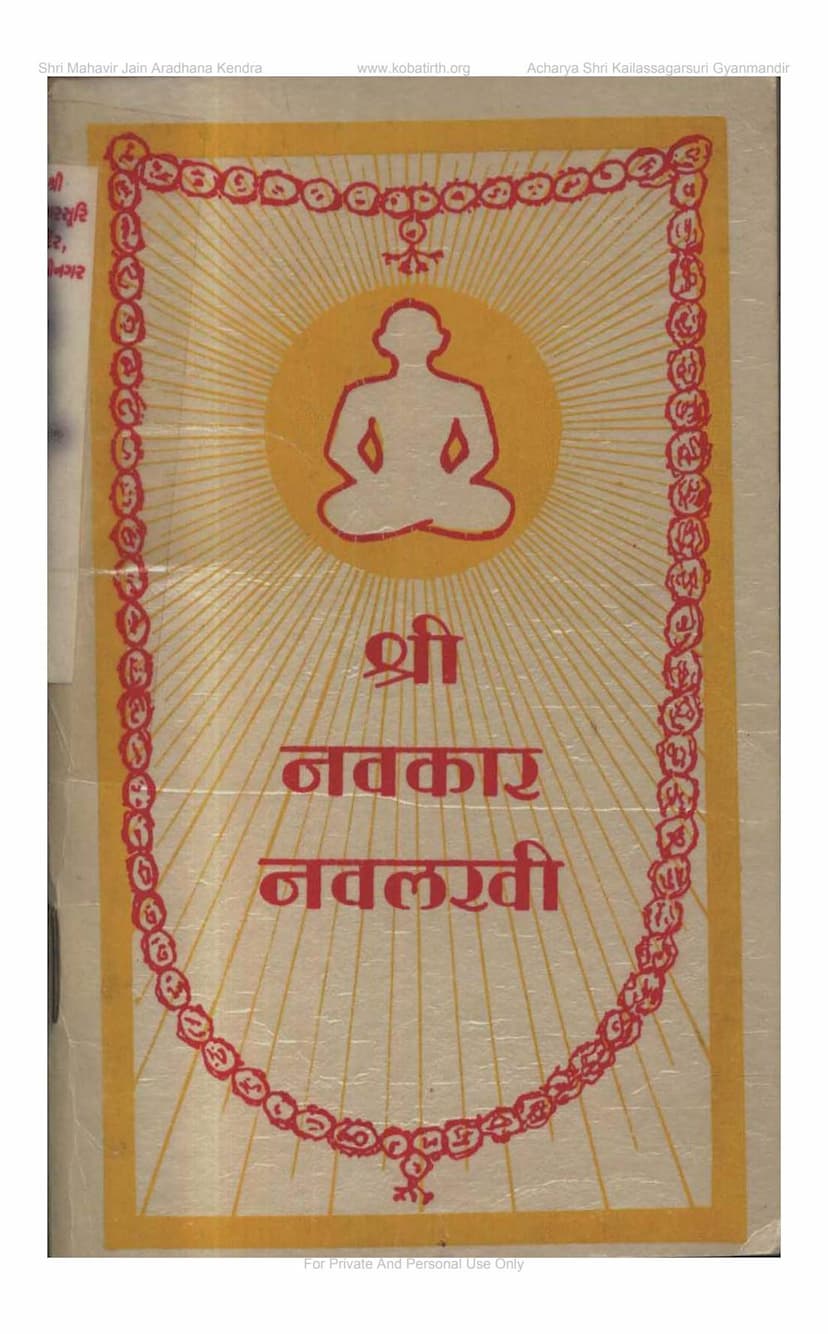Navkar Navlakhi
Added to library: September 2, 2025

Summary
Here's a comprehensive summary of the Jain text "Navkar Navlakhi" based on the provided pages:
Book Title: Navkar Navlakhi Author: Manjulashreeji Publisher: Labdhi Vikramsurishwarji Sanskruti Kendra
Core Message and Purpose:
"Navkar Navlakhi" is a devotional booklet focused on the significance and practice of the Navkar Mahamantra (the fundamental prayer of Jainism). The primary goal of this publication is to encourage devotees to undertake the recitation of the Navkar Mantra nine lakh (9,00,000) times. This specific number is highlighted as an "obligatory course" for all followers of Jainism to achieve spiritual upliftment and progress towards liberation.
Inspiration and Dedication:
The booklet is dedicated to Pujya Acharya Dev Rayash Surishwarji Maharaj Saheb on his 51st birthday. The inspiration for this initiative stems from his profound devotion to the Navkar Mantra, particularly his practice of reciting it continuously, even for a minute's pause. The text mentions that he is believed to have recited millions of Navkar Mantras, and his devotion transformed places into sacred pilgrimage sites.
The Navkar Mahamantra:
The booklet emphasizes that the Navkar Mahamantra is the essence of the 14 Purvas (ancient Jain scriptures) and the lifeblood of Jainism. It is described as a protective shield and a means to achieve self-realization and ultimate liberation. Each of the five lines of the mantra is linked to the five supreme beings of Jainism:
- Namoh Arihantanam: Represents the Arhats (victors over passions).
- Namoh Siddhanam: Represents the Siddhas (liberated souls).
- Namoh Aachariyanam: Represents the Acharyas (heads of the monastic order).
- Namoh Upadhyayanam: Represents the Upadhyayas (spiritual teachers).
- Namoh Loye Savva-Sahunam: Represents all the Sadhus (monks) and Sadhvis (nuns) in the world.
Significance of Reciting the Navkar Mantra:
- Spiritual Growth and Liberation: The mantra is presented as a powerful tool to overcome worldly attachments, ego, and "mamkar" (possessiveness), which are seen as obstacles to realizing one's infinite self.
- Purification and Protection: It is a means to eradicate all sins ("Savva-Pavappanaasono") and provides a protective shield against negative influences.
- Attaining Ultimate Goals: The ultimate aim of this practice is to achieve moksha (liberation) and become "Atma se Paramatma" (from soul to God).
- Positive Rebirths: It is stated that those who complete this nine-lakh recitation will not be reborn in lower realms (hell or as animals) but will attain divine or human births, continuing their spiritual journey.
Practical Guidance for Practice:
The booklet provides practical advice for those who wish to undertake the "Navlakhi" (nine lakh) recitation:
- Daily Practice: It is recommended to recite at least five rounds (malas) of the mantra daily.
- Timing: The ideal time for practice is between 4 AM and 6 AM.
- Materials: Use a white mala and a white seat.
- Direction: Face east or north while chanting.
- Focus: Maintain the sole goal of moksha.
- Guidance: Seek the continuous guidance of a spiritual guru.
- Continuous Learning: Keep reviewing literature related to the Navkar Mahamantra.
The Booklet's Structure:
The latter part of the provided text includes charts and tables (pages 15-50) that appear to be designed to help devotees track their progress in reciting the Navkar Mantra. Each numbered section (e.g., "नं.१४", "नं.१५") indicates a cumulative number of recitations, starting from 25,000 and going up to 9,00,000 (and beyond, as the numbering continues). The instruction "माला फेरकर गोल/सही का चिन्ह लगावें" (After completing a round of the mala, mark a circle/tick) suggests these are trackers or tally sheets.
In summary, "Navkar Navlakhi" is a guiding and motivational text that champions the rigorous practice of the Navkar Mahamantra as a pathway to spiritual enlightenment and ultimate liberation in Jainism, dedicated to a revered Acharya on his significant birthday.